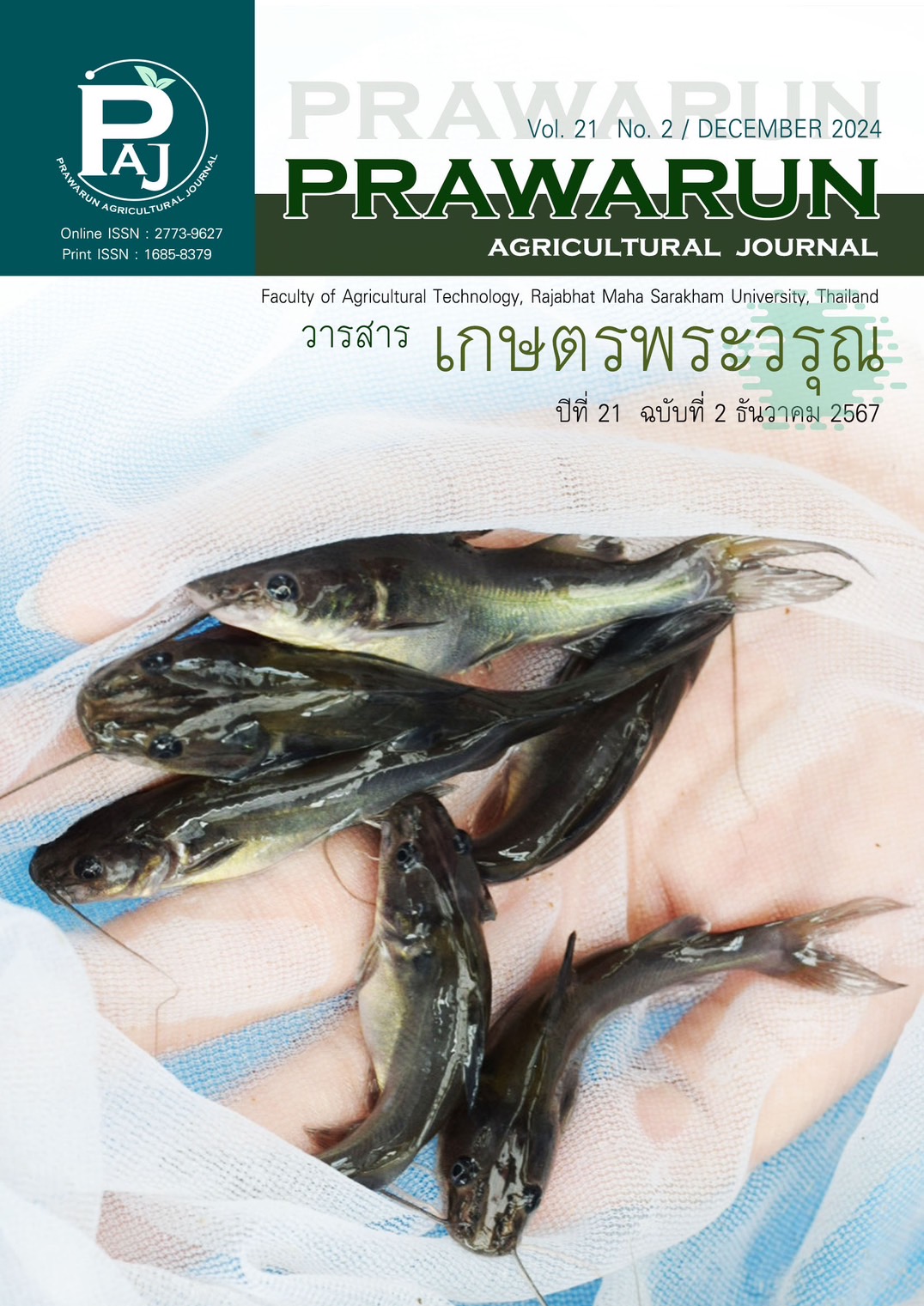ประสิทธิภาพของน้ำหมักชีวภาพที่มีผลต่อการเจริญเติบโตของปลานิลในระบบไบโอฟลอค
Main Article Content
บทคัดย่อ
งานวิจัยนี้มีวัตถุประสงค์เพื่อศึกษาประสิทธิภาพของน้ำหมักชีวภาพในสูตรต่างกันที่มีผลต่อการเจริญเติบโตของปลานิลซึ่งเลี้ยงในระบบไบโอฟลอค โดยวางแผนการทดลองแบบสุ่มสมบูรณ์ ประกอบด้วย 4 ชุดการทดลอง ชุดการทดลองละ 3 ซ้ำ ได้แก่ ชุดการทดลองที่ 1 การเลี้ยงปลานิลด้วยระบบปกติ (ชุดควบคุม) ชุดการทดลองที่ 2 การเลี้ยงปลานิลระบบ ไบโอฟลอคร่วมกับน้ำหมักชีวภาพสูตรอีเอ็ม ชุดการทดลองที่ 3 การเลี้ยงปลานิลระบบไบโอฟลอคร่วมกับน้ำหมักชีวภาพ สูตรจุลินทรีย์บาซิลลัส และชุดการทดลองที่ 4 การเลี้ยงปลานิลระบบไบโอฟลอคร่วมกับน้ำหมักชีวภาพสูตรจุลินทรีย์สังเคราะห์แสง เริ่มต้นเลี้ยงปลานิลน้ำหนักเฉลี่ย 7.68±0.48 เซนติเมตร ความยาวเฉลี่ย 6.52±0.40 กรัม ในตู้กระจกขนาด 24x12x15 นิ้ว (ปริมาตรน้ำ 54 ลิตร) อัตราความหนาแน่น 45 ตัว/ตารางเมตร ให้อาหารสำเร็จรูปวันละ 2 มื้อ ตรวจวัดคุณภาพน้ำทุกสัปดาห์ เป็นเวลา 6 สัปดาห์ เมื่อสิ้นสุดการทดลอง พบว่า การเลี้ยงปลานิลระบบไบโอฟลอคร่วมกับน้ำหมักชีวภาพสูตรอีเอ็มมีการเจริญเติบโตดีที่สุด อัตราการรอดตายสูง (100 %) อัตราการแลกเนื้อต่ำ (0.83) เนื่องจากน้ำหมักชีวภาพสูตรอีเอ็มก่อให้เกิดตะกอนจุลินทรีย์ได้มาก เมื่อนำไปวิเคราะห์พบว่ามีโปรตีน 23.43 % ของน้ำหนักแห้ง โดยทุกชุดการทดลองมีคุณภาพน้ำที่ใกล้เคียงกัน อุณหภูมิน้ำ 28-30 องศาเซลเซียส ค่าความเป็นกรดเป็นด่าง 6.7-8.3 ค่าอัลคาไลนิตี้ 68-119 มิลลิกรัม/ลิตรของแคลเซียมคาร์บอเนต ไนไตรท์ 0-0.5 มิลลิกรัม/ลิตร แอมโมเนียรวม 0-0.2 มิลลิกรัม/ลิตร ปริมาณออกซิเจนที่ละลายในน้ำ 4-5 มิลลิกรัม/ลิตร ปริมาณของแข็งแขวนลอย 100-500 มิลลิกรัม/ลิตร ซึ่งคุณภาพน้ำของทุกชุดการทดลองมีค่าเฉลี่ยไม่แตกต่างจากชุดควบคุม นอกจากนี้ยังพบแพลงก์ตอนสัตว์หลายชนิดในบ่อบำบัดน้ำทิ้งจากระบบ ได้แก่ ไรแดง (Moina macrocopa) และโรติเฟอร์ (Brachionus sp.) ซึ่งเป็นอาหารเสริมสำหรับปลานิลอีกด้วย ส่วนการเลี้ยงปลานิลระบบไบโอฟลอคร่วมกับน้ำหมักชีวภาพสูตรอีเอ็มสามารถบำบัดแอมโมเนียได้ดีทำให้เปลี่ยนถ่ายน้ำน้อยทำให้ประหยัดต้นทุนการเลี้ยง
Article Details
เอกสารอ้างอิง
Association of Official Analytical Chemists (AOAC). (1995). Official methods of analysis (16th ed.). Washington D. C., United States: Association of Official Analytical Chemists.
Avnimelech, Y. (2014). Biofloc technology: a practical guide book (3rd ed.). Baton Rouge, Louisiana, United States: The World Aquaculture Society.
Azim, M. E., & Little, D. C. (2008). The biofloc technology (BFT) in indoor tanks: water quality, biofloc composition, and growth and welfare of Nile Tilapia (Oreochromis niloticus). Aquaculture, 283(1-4), 29-35. doi: 10.1016/j.aquaculture.2008.06.036
Caipang, C. M, A., Choo, H. X., Bai, Z., Huang, H., & Lay-yag, C. M. (2015). Viability of sweet potato flour as carbon source for the production of biofloc in freshwater culture of tilapia, Oreochromis sp. International Aquatic Research, 7(4), 329-336. doi: 10.1007/s40071-015-0117-7
Castro-Nieto, L. M., Castro–Barrera, T., De Lara-Andrade, R., Castro-Mejía, J., & Castro-Mejía, G. (2012). Biofloc systems in aquaculture biofloc systems: a technological breakthrough in aquaculture. Revista Digital del Departamento El Hombre y su Ambiente, 1(1), 1-5.
Chu, C. P., & Lee, D. J. (2004). Multiscale structures of biological flocs. Chemical Engineering Science, 59(8-9), 1875-1883. doi: 10.1016/j.ces.2004.01.040
Emerenciano, M., Ballester, E. L. C., Cavalli, R. O., & Wasielesky, W. (2011). Biofloc technology application as a food resource in a limited water exchange nursery system for pink shrimp Farfantepenaeus brasiliensis (Latreille, 1817). Aquaculture research, 43(3), 447-457. doi: 10.1111/j.1365-2109.2011.02848.x
Fisheries department. (2008a). Nile Tilapia culture. Bangkok, Thailand: Ministry of Agriculture and Cooperatives. (in Thai)
Fisheries department. (2008b). Hormonal Sex-reversed Nile Tilapia culture. Bangkok, Thailand: Ministry of Agriculture and Cooperatives. (in Thai)
Hmadhloo, S., Tanyaros, S., & Phumee, P. (2013). Effect of C:N ratio in integrated culture of white shrimp (Litopenaeus vannamei) and Nile tilapia (Oreochromis niloticus) using biofloc technology. Rajamangala University of Technology Srivijaya Research Journal, 5(1), 96-106. (in Thai)
Jitmanowan, S. (2020). Effect of carbon/nitrogen ratio (C:N) on geosmin in Nile tilapia (Oreochromis niloticus) under biofloc system (Master’s thesis). Chiangmai, Thailand: Maejo University. (in Thai)
Khumsat, U., Lopbamrung, Y., & Buaban, T. (2018). Culture of Nile Tilapia (Oreochromis niloticus) with biofloc technology (Special problem). Nakhonsawan, Thailand: Nakhonsawan Rajabhat University. (in Thai)
Klinngam, S., & Thaklaewphan, C. (2022). Driving AIC Phetchaburi Province towards a high performance AIC center (AIC Phetchaburi Province annual report). Phetchaburi, Thailand: Phetchaburi Rajabhat University. (in Thai)
Nootong K., Pavasant, P., & Powtongsook, S. (2011). Effects of organic carbon addition in controlling inorganic nitrogen concentrations in a biofloc system. Journal of the World Aquaculture Society, 42(3), 339-346. doi: 10.1111/j.1749-7345.2011.00472.x
Nurhatijah, N., Muchlisin, Z. A., Sarong, M. A., & Supriatna, A. (2016). Application of biofloc to maintain the water quality in culture system of the tiger prawn (Penaeus monodon). AACL Bioflux, 9(4), 923-928.
National Research Council (NRC). (1983). Nutrient requirements of warmwater fishes and shellfishes. Washington D. C., United States: National Academy Press.
Phonpisuttimas, S. (2012). Fermented bio-extracts and agricultures. Journal of Research Unit on Science, Technology and Environment for Learning, 3(1), 59-65. (in Thai)
Ray, A. J., Lewis, B. L., Browdy, C. L., & Leffler, J. W. (2010a). Suspended solids removal to improve shrimp (Litopenaeus vannamei) production and an evaluation of a plant-based feed in minimal- exchange, superintensive culture systems. Aquaculture, 299(1-4), 89-98. doi: 10.1016/j.aquaculture.2009.11.021
Ray, A. J., Seaborn, G., Leffler, J. W., Wilde, S. B., Lawson, A., & Browdy, C. L. (2010b). Characterization of microbial communities in minimal-exchange, intensive aquaculture systems and the effects of suspended solids management. Aquaculture, 310(1-2), 130-138. doi: 10.1016/j.aquaculture.2010.10.019
Rucksapram, S., Tungse, W., & Rachuphimon, N. (2021). Biofloc technology and bio-extract applications for indoor culture of Nile Tilapia (Oreochromis niloticus). Journal of Agriculture, 37(3), 243-253. (in Thai)
Sittplangkoon, P., Pungrasmi, W., & Noothong, K. (2012). Control of inorganic nitrogen concentrations and ammonium removal rates by biological sludge from closed aquaculture cultivating system. Proceeding of the 9th Kasetsart University Kamphaeng Saen Campus Conference (pp. 317-323). Bangkok, Thailand: Kasetsart University. (in Thai)
Thanakitpairin, A., Noothong, K., & Pungrasmi, W. (2016). The Effects of biological flocculation from recirculating aquaculture system on controlling the inorganic nitrogen concentrations. Burapha Science Journal, 21(3), 50-57. (in Thai)
Timmons, M. B., Ebeling, J. M., Wheaton, F. W., Summerfelt, S. T., & Vinci, B. J. (2002). Recirculating aquaculture systems (2nd ed.). New York, United States: Cayuga Aqua Ventures Llc.
Vadivelu, V. M., Keller, J., & Yuan, Z. (2007). Effect of free ammonia on the respiration and growth processes of an enriched Nitrobacter culture. Water Research, 41(4), 826-834. doi: 10.1016/j.watres.2006.11.030
Wangwibulkit, S. (2009). Water quality for fisheries. Bangkok, Thailand: Department of Fisheries Science, Faculty of Agricultural Technology, King Mongkut's Institute of Technology Ladkrabang. (in Thai)
Yankay, S. (2022). Effects of different aeration systems on ammonia removal efficiency of biofloc in closed aquaculture system for Litopenaeus vannamei (Master’s thesis). Bangkok, Thailand: Chulalongkorn University. (in Thai)


